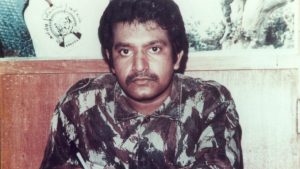

For The Liberation Of The People…

The views and ideas of The National leader Prabhakaran are eagerly awaited by the world community as the leader of the Liberation Movement for control, determination, militancy and commitment to the liberation of my people – as a commander who will effectively lead the war of liberation against a racist and brutal government force!
Prabhakaran’s opinion entitled ‘For the Liberation of the People’ may fulfill this longing.
What were the factors that prompted him to create this liberation organization, which is known in whole world? What are his assessments and views on this liberation organization? This writing will give You the answers for all the questions coming up.
At the same time, whenever the Sinhala chauvinist states take advantage of the changing circumstances and try to suppress the Tamil Eelam Liberation struggle by tactical or armed force, the leader every time made the prophetic decisions in favor of the Tamils. This book will also tell how the leader build up the liberations struggle and move it forward.
Sinhala chauvinism will never do justice to Tamils. The book emphasizes the fact that the only solution to the national ethnic problem of the Tamils is with the privatization of Tamil Eelam. This is what the leader has been prophesying always and now.
One day in the year of 1987….The interference of The Indian Government.
Mr. Dixit – from the Indian Government – used his power to try to take The Tamil Eelam liberation organization into his hands and under his control. When he failed in all missions, he put a talk with the leader.
“You have frustrated us three times now”, said Mr. Dixit. The leader replied calmly:”Oh, then I think I have saved my people three times.”
A few weeks after this incident, the Indian troops started the war. Civilians were massacred and persecuted. The leader subsequently extended a heartfelt appeal to Indian Prime Minister Rajiv Gandhi to stop the war immediately and prevent the destruction of civilians. Rajiv, however, rejected it with authority and said, “I will put Prabhakaran at my feet.”
The war intensified. Despite the catastrophe, with the cooperation of the people, the LTTE began to epic on the battlefield. As the days went by, the Indian forces were permanently embroiled. Now the Indian Government has made indirect calls to the LTTE to negotiate a compromise. The leader, who clearly understood India’s intention to continue the occupation through compromise, rejected the call for compromise and took serious diplomatic action against the Indian forces. He eventually forced the Indian forces to leave Tamil Eelam.
No matter what the Boro-compromise is, the book says that the leader worked tirelessly with prophecy for the lasting welfare of the Tamil people.
Anyone who reads this book can understand how the leader, who faced diplomatic conspiracies and storms of aggression aimed at Tamil Eelam nationalism, has been able to overcome them, both tactfully and decisively.
When the “Sunday” newspaper asked: “Can you tell us about your personal mean that made you to come to the decision that armed struggle is the only solution?”
“When I was a schoolboy, the horrific events of the 1958 ethnic riots had a profound effect on my mind. When I once met a widowed mother known to our family, she told me of her tragic experience in this racism. Sinhala gangsters set fire to her house in Kolhapur and brutally killed her husband. He and his children survived with several burns.
I was very shocked when I saw the burn scars found on his body. I have heard of incidents of small children being thrown alive into boiling tar. I felt deep sympathy and love for my people when I heard how the helpless innocent Tamils were subjected to such a brutal attack.”
It seemed to me that the greatest motivation was to rescue our people from the clutches of this racism. I deeply felt that this organization, which would use armed force against unarmed innocent Tamils, could only be confronted through armed struggle, the leader said, recalling his experience.
The Indian Army, hiding their failure, once said, “We fought against Tamils with one hand”.
When asked the leader about this, “If the Indian Army had committed such atrocities against our people with one hand, it would be heartbreaking to think of the atrocities committed by both hands by the Indian Army.”
There are so many interesting things in this collection that if you evaluate the book as a whole, it can be said that the decade-long history of the LTTE movement is encapsulated in this collection of books.
The collection includes periodic interpretations and reviews by the national leader, turning points, political crises, war operations, and state terrorist atrocities. The book includes not only political situations and situations of struggle, but also policy explanations given by the national leader on various issues such as education, economics, art literature, women’s emancipation, and the administration of justice.
In short, “For the Liberation of My People” is a vibrant historical book that should be read in the homes of all Tamils.
